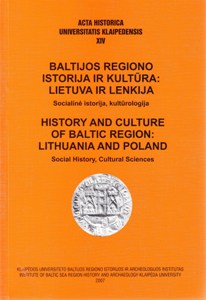Volume 14 (2007): Baltijos regiono istorija ir kultūra: Lietuva ir Lenkija. Socialinė istorija, kultūrologija = History and Culture of Baltic Region: Lithuania and Poland. Social History, Cultural Sciences, December 2007

Order by:
Pub. online: 9 Dec 2007
Type: Introduction
 Open Access
Open Access
Journal:
Acta Historica Universitatis Klaipedensis
Volume 14 (2007): Baltijos regiono istorija ir kultūra: Lietuva ir Lenkija. Socialinė istorija, kultūrologija = History and Culture of Baltic Region: Lithuania and Poland. Social History, Cultural Sciences, pp. 5–8
Pub. online: 9 Dec 2007
Type: Article
 Open Access
Open Access
Journal:
Acta Historica Universitatis Klaipedensis
Volume 14 (2007): Baltijos regiono istorija ir kultūra: Lietuva ir Lenkija. Socialinė istorija, kultūrologija = History and Culture of Baltic Region: Lithuania and Poland. Social History, Cultural Sciences, pp. 9–23
Abstract
Pub. online: 9 Dec 2007
Type: Article
 Open Access
Open Access
Journal:
Acta Historica Universitatis Klaipedensis
Volume 14 (2007): Baltijos regiono istorija ir kultūra: Lietuva ir Lenkija. Socialinė istorija, kultūrologija = History and Culture of Baltic Region: Lithuania and Poland. Social History, Cultural Sciences, pp. 87–93
Abstract
Pub. online: 9 Dec 2007
Type: Article
 Open Access
Open Access
Journal:
Acta Historica Universitatis Klaipedensis
Volume 14 (2007): Baltijos regiono istorija ir kultūra: Lietuva ir Lenkija. Socialinė istorija, kultūrologija = History and Culture of Baltic Region: Lithuania and Poland. Social History, Cultural Sciences, pp. 95–107
Abstract
Pub. online: 9 Dec 2007
Type: Article
 Open Access
Open Access
Journal:
Acta Historica Universitatis Klaipedensis
Volume 14 (2007): Baltijos regiono istorija ir kultūra: Lietuva ir Lenkija. Socialinė istorija, kultūrologija = History and Culture of Baltic Region: Lithuania and Poland. Social History, Cultural Sciences, pp. 109–118
Abstract
Pub. online: 9 Dec 2007
Type: Article
 Open Access
Open Access
Journal:
Acta Historica Universitatis Klaipedensis
Volume 14 (2007): Baltijos regiono istorija ir kultūra: Lietuva ir Lenkija. Socialinė istorija, kultūrologija = History and Culture of Baltic Region: Lithuania and Poland. Social History, Cultural Sciences, pp. 119–132
Abstract
Pub. online: 9 Dec 2007
Type: Article
 Open Access
Open Access
Journal:
Acta Historica Universitatis Klaipedensis
Volume 14 (2007): Baltijos regiono istorija ir kultūra: Lietuva ir Lenkija. Socialinė istorija, kultūrologija = History and Culture of Baltic Region: Lithuania and Poland. Social History, Cultural Sciences, pp. 133–144
Abstract
Pub. online: 9 Dec 2007
Type: Article
 Open Access
Open Access
Journal:
Acta Historica Universitatis Klaipedensis
Volume 14 (2007): Baltijos regiono istorija ir kultūra: Lietuva ir Lenkija. Socialinė istorija, kultūrologija = History and Culture of Baltic Region: Lithuania and Poland. Social History, Cultural Sciences, pp. 145–157
Abstract
Pub. online: 9 Dec 2007
Type: Article
 Open Access
Open Access
Journal:
Acta Historica Universitatis Klaipedensis
Volume 14 (2007): Baltijos regiono istorija ir kultūra: Lietuva ir Lenkija. Socialinė istorija, kultūrologija = History and Culture of Baltic Region: Lithuania and Poland. Social History, Cultural Sciences, pp. 159–166
Abstract
Pub. online: 9 Dec 2007
Type: Article
 Open Access
Open Access
Journal:
Acta Historica Universitatis Klaipedensis
Volume 14 (2007): Baltijos regiono istorija ir kultūra: Lietuva ir Lenkija. Socialinė istorija, kultūrologija = History and Culture of Baltic Region: Lithuania and Poland. Social History, Cultural Sciences, pp. 167–174
Abstract